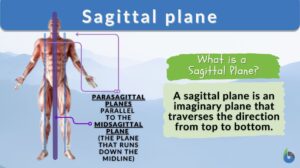
Sagittal plane
n., plural: sagittal planeS
[ˈsæd͡ʒ.ət.əl pleɪn]
Definition: A plane that is traversing the direction from top to bottom
Table of Contents
The sagittal plane is the plane that allows us to see the world in bilateral symmetry. Whether reaching for a high shelf, running a marathon, or simply standing still, the sagittal plane is always at work, dividing our body into distinct, interconnected parts, and allowing us to move with grace and precision.
The human body is a wondrous machine, comprising a multitude of systems working together to keep us alive and thriving. From medical professionals to fitness enthusiasts, understanding human anatomy and physiology is vital. When describing human anatomy and its critical aspects, the different anatomical planes of the body allow us to comprehend the orientation and standard anatomical position of various body parts relative to each other.
Three principal body planes or three basic reference planes namely sagittal, coronal, and transverse planes, divide the human body into sections, providing insight into the complex interplay between different body parts and systems. Look at the table below for a comparative overview of the different planes.
Table 1: Differences between the 3 different planes |
||||
|---|---|---|---|---|
| Plane | Plane | Plane | Plane | Plane |
| Sagittal plane/ longitudinal plane | Divides the body into left and right sections | Medial-lateral axis | Forward and backward movements | Spine, nose, navel, head |
| Coronal or frontal plane | Divides the body into front and back sections | Anterior-posterior axis | Side-to-side movements | Lungs, heart, liver, stomach |
| Transverse plane/ axial plane/ horizontal plane | Divides the body into top and bottom sections | Superior-inferior axis | Twisting movements | Brain, eyes, ears, pelvis |
Data Source: Akanksha Sexena of Biology Online
In this article, our point of focus will be one of the three planes, the sagittal plane. As we unravel the intricacies of this plane, we will discover the critical role it plays in the fields of anatomy and medical science.
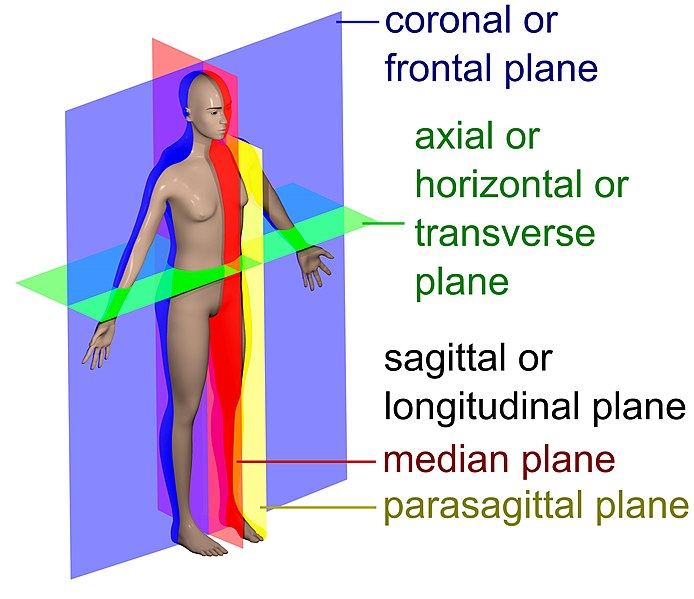
Sagittal Plane Definition
The sagittal plane is defined as an imaginary plane running from the top to the bottom of the human body which results in the formation of 2 different portions- left and right portions of the body.
For easy understanding, you can imagine slicing your body from top to bottom into two halves. The plane that divides your body into two left and right sections is called the sagittal plane. The two sections might be equal (mide-sagittal) or unequal (parasagittal). Thus, the sagittal plane’s like a line running down the middle of your body, separating your body into mirror images (mid-sagittal plane).
-
Etymology
The word sagittal plane has been derived from a first Latin word called “sagitta” which means ‘arrow’ and a second Latin word called “planum” which means ‘flat surface’.
-
Essential uses of Sagittal Plane
For physicians and medical professionals: The sagittal plane is essential to help us understand how different parts of our bodies relate to each other. It allows doctors to see how the bones, muscles, and organs inside our bodies are positioned and how they work together.
For example, if you were to see an X-ray of your spine, you would see the sagittal plane as it divides your spine into left and right halves. The sagittal plane is an essential concept in anatomy and is crucial for understanding the complex systems of our body.
For fitness and sport science: The sagittal plane is used to study and analyze the movement of the body. It is often used in sports science and physical therapy to assess movement patterns and identify areas of weakness or injury. Sagittal plane exercises mainly involve flexion and extension joint motions. Example: Squats, deadlifts, bicep curls.

For the human body: Bilateral symmetry mediated by the sagittal plane facilitates smoother and coordinated movement of the animal’s body parts, resulting in enhanced efficiency.
For the diversity in the animal kingdom: Bilateral symmetry mediated by the sagittal plane has enabled the development of specialized structures and organs such as the brain and circulatory system, contributing to the vast diversity of the animal kingdom.
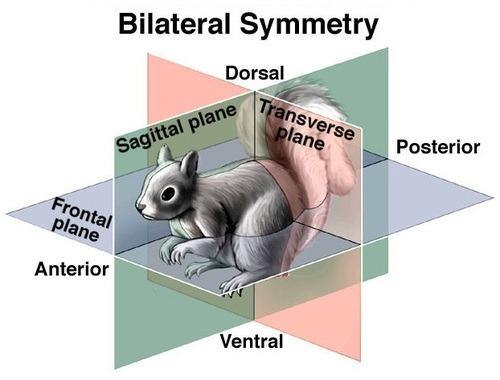
-
Movements around Sagittal Axis
Abduction/Adduction movements are the movements that occur in the frontal plane around the sagittal axis, which is perpendicular to the sagittal plane. This type of movement involves moving a body part away from or towards an imaginary centerline, with the centerline in alignment with the sagittal axis. On the other hand, movement in the sagittal plane takes place around the frontal axis, which is perpendicular to both the sagittal and transverse planes.
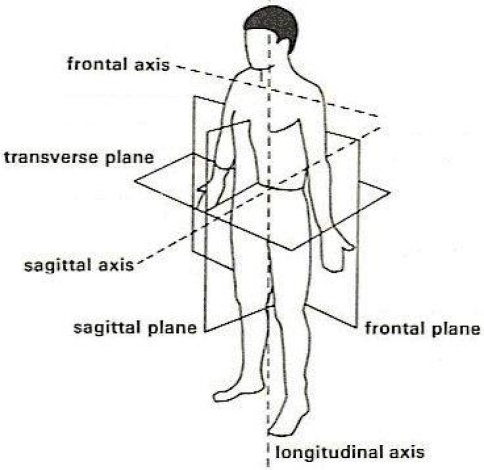
-
Related Terminologies
There are some related terminologies to the sagittal plane like a mid-sagittal plane and parasagittal plane.
The parasagittal plane is the term used to refer to a plane situated alongside or parallel to the mid-sagittal plane, but not including the mid-sagittal or median plane itself. A popular study example is the midclavicular line that crosses the clavicle. Even all the other sagittal planes except the mid-sagittal plane area are called parasagittal planes.
The mid-sagittal plane is a plane passing vertically through the midline, subsequently dividing the body into left and right halves of equal proportion particularly in a body exhibiting bilateral symmetry. In the human body, a mid-sagittal plane is passing through the midline structures such as the navel and spine. Together with the umbilical plane, it is the mid-sagittal plane that ensures the formation of the 4 quadrants of the human abdomen.
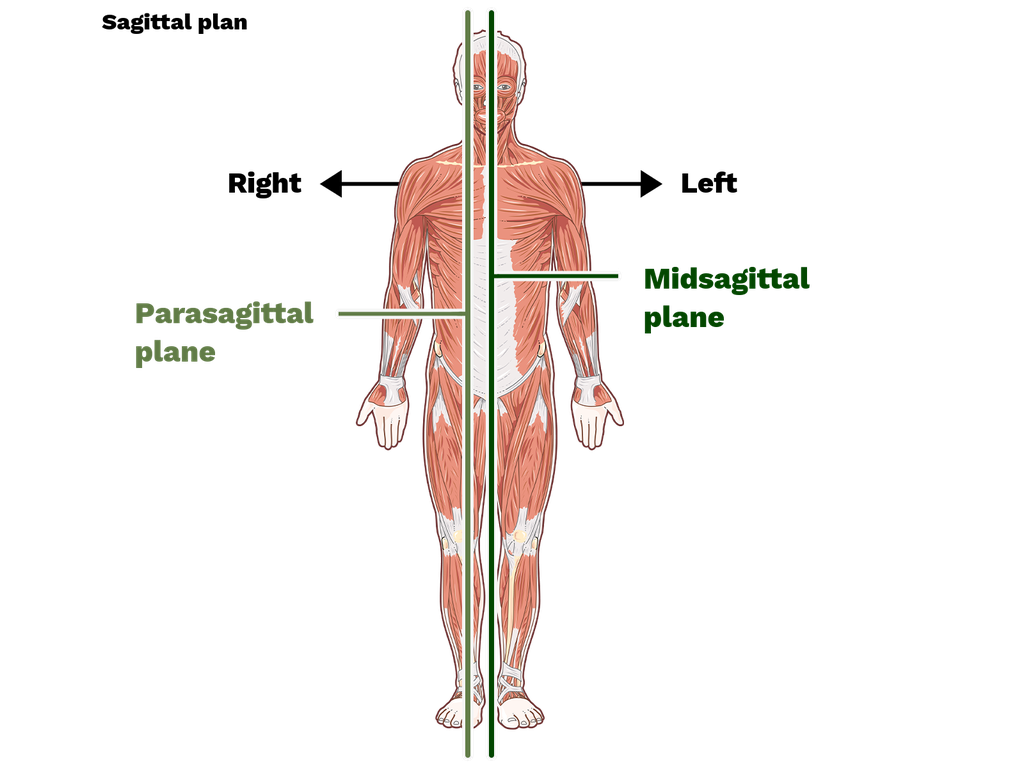
-
Sagittal versus Mid-sagittal Plane
The mid-sagittal plane is also called the “median plane” since it is a specific type of sagittal plane that divides the body into “two equal left and right halves”. It runs vertically through the body’s center, dividing it into mirror-image halves. In contrast, the sagittal plane is any vertical plane that divides the body into left and right sections, regardless of whether it divides the body into equal halves.
The key difference between the mid-sagittal plane and the sagittal plane is that the mid-sagittal plane is a specific type of sagittal plane that divides the body into two halves, while a sagittal plane can divide the body into unequal left and right sections.
Uses of mid-sagittal plane: The mid-sagittal plane is often used as a reference point in medical imaging and anatomical descriptions, as it allows for a precise visualization and analysis of the body’s structures and organs.
Watch this vid about the sagittal plane:
Biology definition:
A sagittal plane is a term used in anatomy to refer to a plane that is traversing the direction from top to bottom, and therefore, forms left and right sections, especially in the body of a bilaterally symmetrical animal. Related terms are the mid-sagittal plane and the parasagittal plane. The mid-sagittal plane is a plane passing vertically through the midline, subsequently dividing the body into left and right halves of equal proportion particularly in a body exhibiting bilateral symmetry. The parasagittal plane is the term used to refer to a plane situated alongside or parallel to the sagittal plane, but not including the median plane passing through the midline. An example is the midclavicular line crossing through the clavicle.
Variations In Terminology
There are some common variations and usage differences for the term sagittal plane. They are:
- Median plane
- Mid-sagittal plane
- Parasagittal plane
NOTE IT!
“Sagittal Plane and the Evolution of Bilateral Symmetry”
The sagittal plane is a characteristic feature of the bodies of “bilaterally symmetrical animals”. Bilaterally symmetrical animals are those that can be divided into two identical halves or have mirror images along a single plane, i.e., the mid-sagittal plane. This type of symmetry is found in a wide variety of animals, from insects to human beings.
Bilateral symmetry facilitates smoother and coordinated movement of the animal’s body parts, resulting in enhanced efficiency. For example, if an animal has bilateral symmetry, it can move its limbs in a coordinated manner, allowing it to move through its environment more effectively.
The origins and development of bilateral symmetry have long been a topic of interest for scientists. The first animals are thought to have had radial symmetry, with their body parts arranged in a circular pattern around a central axis. However, over time, some animals evolved bilateral symmetry, with a distinct front and back end, as well as a left and right side. There are several theories related to this evolutionary development.
One theory proposes that this evolution of bilateralism is interlinked to more efficient movement and coordination of body parts, resulting in an advantage for bilaterally symmetrical animals in finding food, avoiding predators, and competing for resources.
Another theory posits that the development of bilateralism was driven by the evolution of more complex nervous systems, which required an organized body plan to support neural networks. Regardless of the evolutionary drivers, bilateral symmetry has proved highly successful, enabling the development of specialized structures and organs such as the brain and circulatory system, contributing to the vast diversity of the animal kingdom.
While the exact drivers of bilateralism’s evolution are still debated among scientists, it is clear that the successful development of bilateral symmetry has played a critical role in the evolution of animal life on Earth.

Take the Sagittal Plane – Biology Quiz!
References
- Benítez, H., Lemic, D., Villalobos-Leiva, A., Bažok, R., Órdenes-Claveria, R., Pajač Živković, I., & Mikac, K. (2020). Breaking Symmetry: Fluctuating Asymmetry and Geometric Morphometrics as Tools for Evaluating Developmental Instability under Diverse Agroecosystems. Symmetry, 12(11), 1789. MDPI AG. Retrieved from http://dx.doi.org/10.3390/sym12111789
- de Oliveira Sato, T., Hansson, G. Å., & Coury, H. J. (2010). Goniometer crosstalk compensation for knee joint applications. Sensors (Basel, Switzerland), 10(11), 9994–10005. https://doi.org/10.3390/s101109994
©BiologyOnline.com. Content provided and moderated by Biology Online Editors.

